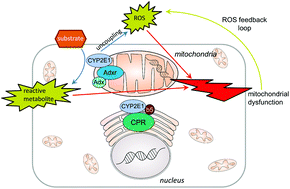Toxicological implications of mitochondrial localization of CYP2E1
Abstract
Cytochrome P450 2E1 (CYP2E1) metabolizes an extensive array of pollutants, drugs, and other small molecules, often resulting in bioactivation to reactive metabolites. Therefore, it is unsurprising that it has been the subject of decades of research publications and reviews. However, while CYP2E1 has historically been studied in the endoplasmic reticulum (erCYP2E1), active CYP2E1 is also present in mitochondria (mtCYP2E1). Relatively few studies have specifically focused on mtCYP2E1, but there is growing interest in this form of the enzyme as a driver in toxicological mechanisms given its activity and location. Many previous studies have linked total CYP2E1 to conditions that involve mitochondrial dysfunction (fasting, diabetes, non-alcoholic steatohepatitis, and obesity). Furthermore, a large number of reactive metabolites that are formed by CYP2E1 through metabolism of drugs and pollutants have been demonstrated to cause mitochondrial dysfunction. Finally, there appears to be significant inter-individual variability in targeting to the mitochondria, which could constitute a source of variability in individual response to exposures. This review discusses those outcomes, the biochemical properties and toxicological consequences of mtCYP2E1, and highlights important knowledge gaps and future directions. Overall, we feel that this exciting area of research is rich with new and important questions about the relationship between mtCYP2E1, mitochondrial dysfunction, and pathology.



 Please wait while we load your content...
Please wait while we load your content...